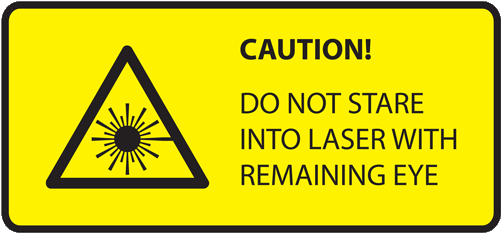Laser Safety
The lasers used in OpenSPIMs are typically Class 3B, which means they are dangerous to the eye. This classification means that direct exposure of the eye by the laser is harmful and will destroy your retina ("might burn a small hole/blind spot"). This is also true for any reflections from shiny surfaces (rings, bracelets, watches, belt buckles, tools, ...). Diffuse reflections, i.e. reflections from matte surfaces such as paper, anodized aluminum etc., are generally not dangerous.
So when aligning an optical system you should follow some simple rules to increase your safety:
- You are also responsible for the safety of anybody else in the same room, so warn everybody, when you use a laser and tell them what to watch out for.
- Anybody using a laser (or in our case the OpenSPIM) has to get an introduction to laser safety. Make sure everybody knows what he or she is doing and what to watch out for.
- Remove any jewelry from your hands (ring, watches, bracelets, ...), best even cover your belt buckle with your clothes.
- Wear laser safety glasses (although they might be uncomfortable or at times unpractical).
- When aligning, reduce the laser power to a safe setting (i.e. <1mW, which is generally considered safe in the visible range).
- Don't look directly into the beam or the end of an optical fiber ('' ... with your remaining eye ;-)'').
- Before entering an optical setup with a shiny tool (e.g. an spanners and wrenches) or a new optical element: block the laser and/or make sure you cannot be hit by a stray beam.
- Keep the optical beams in one plane (and therefore predictable), which makes it easy to shield them off. If possible put up a poster with the optical setup next to the SPIM, so people can look up what that thingy on the table is and how it works.
- If possible, lead the laser beams inside an enclosure.
- The lasers have to be marked with the appropriate warning signs. Also the room should be marked outside with a warning sign and at least this information: (max.) laser class, laser wavelength, laser power.
- Note that in some countries (e.g. Germany) you need laser safety certified staff in your university/company/institute/... when operating lasers of classes 3R, 3B and 4. Otherwise there might be no insurance against accidents with laser radiation. Find out who that is and show them your setup.
Disclaimer: This list of rules is in no way complete or guarantees that nobody gets harmed! But following them should prevent most accidents.
